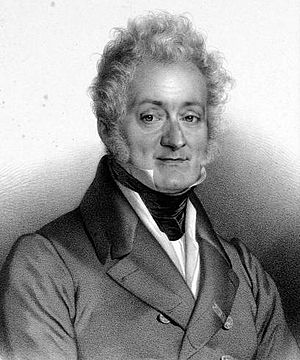Ferdinando Paer facts for kids
Ferdinando Paer (born July 1, 1771 – died May 3, 1839) was a famous Italian composer. He was best known for writing operas, which are plays set to music. His family was from Austria, and he used different spellings for his name, like Pär and Paër.
Contents
Life and Career of Ferdinando Paer
Ferdinando Paer was born in Parma, Italy. His family was very musical. His father, Giulio Paer, played the trumpet for the Duke's guards and at church events. Ferdinando was named after Ferdinand, Duke of Parma, by the Duchess, Maria Amalia, Duchess of Parma.
Early Musical Training
Ferdinando studied music theory with a violinist named Gasparo Ghiretti. Ghiretti was a student from a famous music school in Naples. Paer's first Italian opera, Circe, was performed in Venice in 1792. After that, many more operas quickly followed, and he became well-known across Italy.
Working in Vienna and Dresden
In 1797, Paer moved to Vienna, Austria. His future wife, a singer named Francesca Riccardi, had a job there. Paer became the music director at the Kärntnertortheater, a famous theater in Vienna, until 1801. During this time, he created several operas, including Camilla (1799) and Achille (1801). The Empress Marie Therese, who loved music, supported him, and he wrote several pieces for her private concerts.
In 1802, Paer was hired as a composer for the court theater in Dresden, Germany, called the Morettisches Opernhaus. His wife also sang there. By 1804, he was given a lifetime job as the Court Kapellmeister, which means he was the main music director for the Elector Frederick Augustus I of Saxony.
Paer's Opera Leonora
Paer's opera Leonora (1804) tells a similar story to Beethoven's famous opera Fidelio. Beethoven's Fidelio was first performed as Leonora the year after Paer's. Beethoven thought highly of Paer's music. He even joked that the funeral march in Paer's Achille was so good that he wished he had composed it himself!
Working for Napoleon
In 1807, the French leader Napoleon was in Dresden and really liked Paer's music. Napoleon took Paer with him to Warsaw and Paris, paying him a very good salary. Paer even composed a special march for Napoleon's wedding to Marie Louise, Duchess of Parma in 1810.
The Success of Agnese
In 1809, Paer wrote his most famous opera, Agnese. This opera was a "dramma semiserio," meaning it had both serious and funny parts. It became very popular all over Europe and was performed in major cities like Milan, London, and Paris. Many famous musicians and critics, including Berlioz and Chopin, admired it. People loved the beautiful music and the dramatic story, especially a powerful scene where the character Agnese's father, Uberto, goes mad.
Later Years in Paris
In 1812, Paer took over from another composer, Spontini, as the conductor of the Opéra-Italien in Paris. He kept this job even after the French monarchy was restored. He also became a composer for the king and a conductor for the private orchestra of the Duke of Orléans.
In 1823, Paer left the Opéra-Italien, and Rossini took his place. Around this time, Paer taught music composition to a young and talented musician named Franz Liszt. In 1831, Paer was chosen to be part of the Académie des Beaux-Arts, a famous French arts academy. In 1832, he was made the conductor of the royal orchestra for King Louis Philippe. Ferdinando Paer passed away in Paris in 1839 at the age of 67.
Paer wrote a total of 55 operas. His style was similar to other Italian classical composers like Paisiello and Cimarosa. He also wrote religious music, cantatas (pieces for singers and instruments), many songs, and some orchestral pieces.
Works
- 1803: Il Santo Sepolcro / La Passione di Gesù Cristo (These are religious musical works, like an opera but without costumes or staging.)
See also
 In Spanish: Ferdinando Paër para niños
In Spanish: Ferdinando Paër para niños


